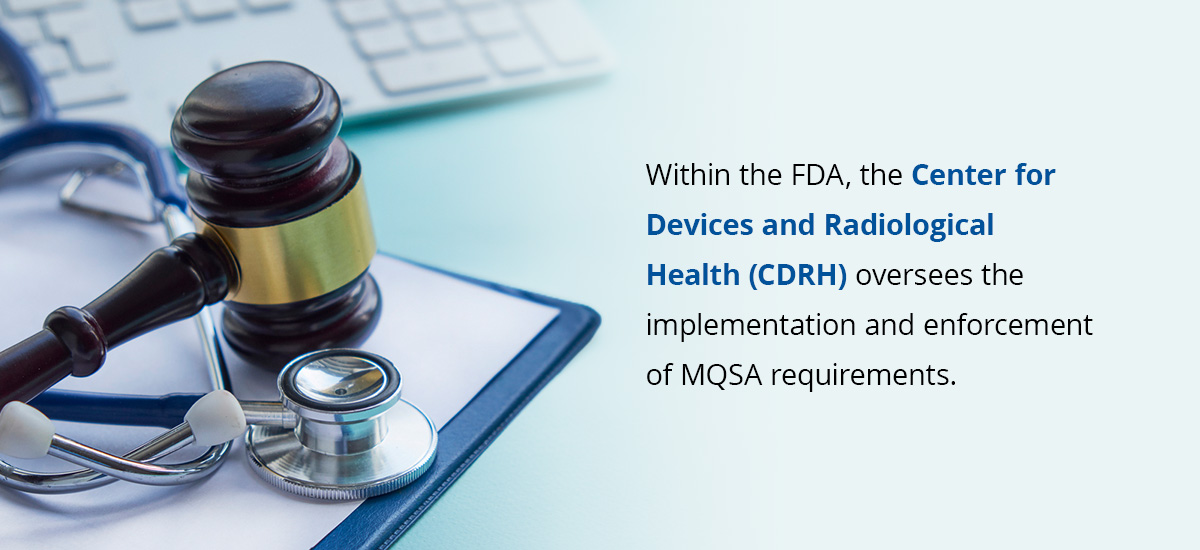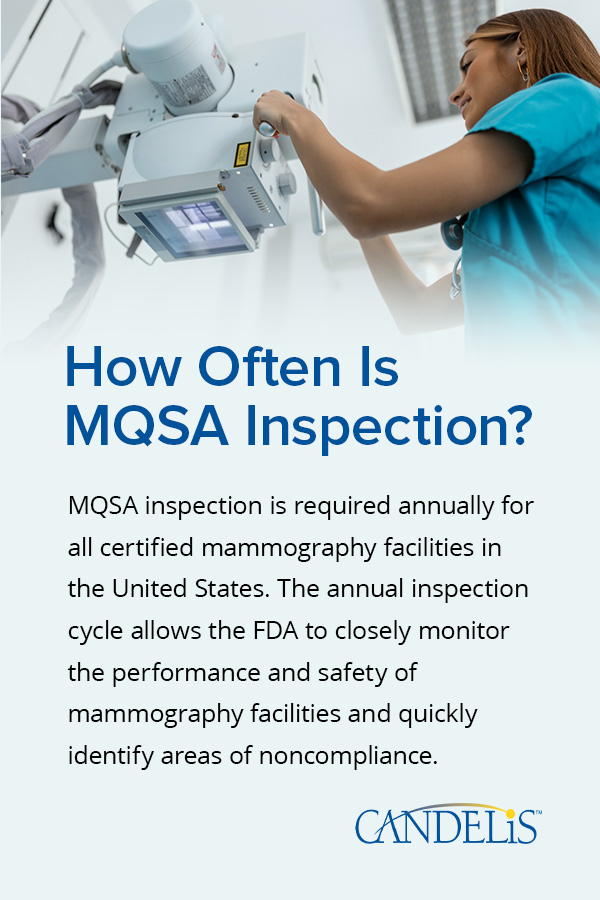MQSA Requirements for Mammography Practices

Mammography is a critical diagnostic tool in the early detection and treatment of breast cancer. The Mammography Quality Standards Act (MQSA) was enacted to ensure the highest quality mammography services and patient safety. This comprehensive federal law sets strict standards for mammography facilities across the United States. In this article, we will delve into the MQSA requirements for mammography practices, exploring the act's history, essential requirements, enforcement, inspections, violations and certifications.
What Is the Mammography Quality Standards Act?
MQSA in mammography stands for the Mammography Quality Standards Act (MQSA), a federal law regulating the quality and safety of mammography services in the United States. Enacted by Congress in the 1990s, the MQSA aims to ensure that all mammography facilities provide consistent, high-quality imaging services to detect breast cancer in its early stages. The act mandates that mammography facilities meet strict equipment, personnel and practices standards to maintain MQSA compliance.
Key features of the MQSA include:
- Mammography facilities must be MQSA-certified to operate lawfully and provide quality services.
- Facilities must be accredited by a Food and Drug Administration (FDA)-approved body.
- Mammography facilities must undergo periodic review of clinical images, have an annual survey by a medical physicist and meet federally developed quality standards.
- Mammography facilities must have annual inspections by federally trained and certified government personnel to ensure compliance with MQSA standards.
The MQSA applies to all facilities that perform mammography, except those under the Department of Veterans Affairs, which has developed its own quality program similar to MQSA. The requirements cover personnel, equipment, radiation dose, quality assurance programs, record-keeping and reporting.
When Did MQSA Start?
The Mammography Quality Standards Act (MQSA) was signed into law on October 27, 1992. The act was written and signed in response to growing concern about the quality and consistency of mammography services in the United States. Before the MQSA, no national standards for mammography facilities, equipment, personnel or reporting practices existed.
The implementation of the MQSA began in 1994 when the FDA published interim regulations for mammography facilities. These regulations outlined the initial requirements for equipment, personnel, quality assurance and record-keeping. Over the following years, the FDA refined and expanded the MQSA regulations based on input from health care professionals, consumer advocates and the public.
The 1997 MQSA Update

In 1997, MQSA regulations were updated. All mammography facilities were required to comply with the new standards by October 1, 1999. The regulations included specific requirements for:
- Mammography equipment performance.
- Personnel qualifications and continuing education.
- Quality assurance programs.
- Medical records and reporting.
- Patient notification results.
Since the implementation of the updated MQSA in 1999, the FDA has continued to update and adjust the regulations to keep pace with advances in mammography technology and best practices in breast cancer detection and diagnosis. These updates included the incorporation of digital mammography and tomosynthesis (3D mammography) into the MQSA standards.
The 2023 MQSA Update
The newest MQSA regulations were published on March 10, 2023. They included specific requirements for:
- Mammography reports and patient lay summaries.
- Communication of results.
- Medical outcomes audit.
- Personnel records.
- Transfer of records and record-keeping.
- Equipment requirements.
- Accreditation failures.
- Facility responsibility to self-referred patients.
The FDA requires all mammography facilities to comply with this new update by September 10, 2024.
What Are the MQSA Requirements?
The MQSA requirements for mammography practices encompass many standards to ensure the highest quality mammography services. Adherence to these comprehensive requirements is essential for maintaining MQSA compliance and ensuring patients receive the highest quality mammography services.
Equipment
MQSA requires the following equipment guidelines:
- Mammography units must meet strict performance standards for image quality, radiation dose and system reliability.
- Facilities must follow manufacturer-recommended maintenance and calibration schedules to ensure optimal equipment performance.
- A qualified medical physicist must conduct annual physics surveys to assess each mammography unit's performance and identify areas for improvement.
- All mammography devices must meet FDA-approved authorization requirements.
Personnel
Personnel requirements include:
- Facilities must have qualified and licensed personnel, including interpreting physicians (radiologists), radiologic technologists and medical physicists.
- Interpreting physicians must be licensed to practice medicine, be certified in radiology and meet specific initial and continuing education requirements in mammography.
- Radiologic technologists must be licensed or certified in radiography and meet specific initial and continuing mammography education requirements.
- Medical physicists must be licensed or approved by an appropriate state or federal agency and meet specific initial and continuing education requirements in mammography physics.
- Facilities must provide their employees with copies of their MQSA qualification records.
- Facilities must keep personnel records for at least 24 months after they leave, whether the employee leaves voluntarily or not.
- Facilities must be able to provide former employee records at inspections or to the former employee upon request for at least 24 months.
Quality Assurance
Facilities can ensure quality assurance by meeting these requirements:
- Facilities must establish and maintain a comprehensive quality assurance program.
- Mammography equipment must undergo regular quality control tests.
- Facilities must conduct annual medical audits and outcome analyses.
- Facilities must promptly implement corrective actions to address any quality assurance deficiencies.
- The mammography medical outcomes audit report must contain specific metrics, including positive predictive value (PPV), cancer detection rate (CDR) and recall rate (RR).
Medical Records and Reporting
All facilities must satisfy the following:
- Facilities must maintain accurate and complete medical records for each patient for at least five years if a patient comes for regular checkups or 10 years if no additional mammograms were performed at the facility.
- Mammography reports must contain specific information, such as the patient’s name, examination date, breast density and overall assessment category.
- Facilities must communicate mammography results to patients and their designated health care providers within specific timeframes.
- Patients must receive a written lay-language summary of their mammography results within 30 days of the examination.
- Facilities must keep original mammographic images and transfer them within 15 calendar days upon request.
- Mammography facilities must have and enforce policies and procedures to minimize record loss.
- Mammograms must be submitted for interpretation in the modality (technology for breast radiography) they were initially produced.
- Facilities are prohibited from scanning, copying or digitizing images to satisfy record retention requirements.
- Before closure, facilities must arrange access to mammography images and reports for patients and their health care providers.
Who Enforces MQSA?

The FDA is the federal agency responsible for enforcing the Mammography Quality Standards Act. Within the FDA, the Center for Devices and Radiological Health (CDRH) oversees the implementation and enforcement of MQSA requirements. Specifically, the Division of Mammography Quality Standards, part of OHT8 — Office of Radiological Health — is responsible for the FDA’s mammography program.
The FDA works with state and local agencies and federally approved accreditation bodies to ensure mammography facilities maintain MQSA compliance. The accreditation bodies, such as the American College of Radiology (ACR) and the States of Arkansas and Texas, are authorized by the FDA to evaluate and accredit mammography facilities based on their adherence to MQSA standards.
The FDA’s enforcement activities include annual inspections, accreditation oversight, enforcement actions, facility certification and maintaining a publicly accessible database of certified mammography facilities.
What Does an MQSA Inspection Entail?
An MQSA inspection is a thorough evaluation of a mammography facility’s compliance with the MQSA requirements. The FDA or its designated state or local agencies conduct inspections annually to ensure facilities maintain the highest mammography quality assurance and patient safety standards.
During an MQSA inspection, the inspector will review various aspects of the facility’s operations, including:
Equipment
An inspector will conduct the following to check equipment:
- The inspector will examine each mammography unit to ensure it meets MQSA performance standards for image quality, radiation dose and system reliability.
- They will review the facility’s maintenance and calibration records to verify that the equipment is properly maintained and serviced according to manufacturer recommendations.
- The inspector will also review the facility’s medical physicist’s survey reports to confirm that annual physics surveys are conducted and identified deficiencies are addressed.
Personnel
Personnel inspections include:
- The inspector will review the qualifications, licenses and continuing education records of the mammography facility’s interpreting physicians, radiologic technologists and medical physicists to ensure they meet MQSA requirements.
- The inspector may also observe personnel performing mammography examinations to assess their technique, patient positioning and adherence to facility protocols.
Quality Assurance
The inspector will confirm quality assurance by analyzing the following:
- The inspector will examine the facility’s quality assurance program, including quality control test records, to ensure that regular equipment checks and performance evaluations are being conducted and documented.
- They will review the facility’s medical audit and outcome analysis data to assess the accuracy and consistency of mammography interpretations and patient management recommendations.
- The inspector will also verify that corrective actions are implemented promptly to address quality assurance deficiencies.
Medical Records and Reporting
Expect the MQSA inspector to review the following aspects of records and reporting:
- The inspector will review a sample of patient medical records to ensure they are complete and accurate and include all required information.
- They will verify that mammography reports contain the necessary elements and are communicated to patients and their designated health care providers within the required timeframes.
- The inspector will also confirm that patients receive a written lay-language summary of their mammography results within 30 days of the examination.
What Is an MQSA Report?
If the inspector identifies any areas of noncompliance, they will notify the facility and allow them to correct deficiencies before the FDA takes further enforcement action. The results of the MQSA inspection, known as an MQSA report, will outline any violations or areas for improvement.

How Often Is MQSA Inspection?
MQSA inspection is required annually for all certified mammography facilities in the United States. The annual inspection cycle allows the FDA to closely monitor the performance and safety of mammography facilities and quickly identify areas of noncompliance.
The FDA may conduct more frequent inspections if a facility has a history of noncompliance or if there are concerns about its performance. For example, if a facility has received a warning letter or been subject to enforcement action in the past, the FDA may schedule additional inspections to verify corrective measures were implemented and sustained.
Mammography facilities that have undergone significant changes, such as installing new mammography equipment, relocating to a new address or changing key personnel, may be subject to additional inspections to verify their continued compliance with MQSA requirements.
Facilities that fail to pass their annual inspection may be subject to enforcement actions and must take prompt corrective action to demonstrate compliance before resuming mammography services.
MQSA Violations
MQSA violations occur when a mammography facility fails to meet one or more of the requirements set forth by the MQSA. These violations can range from minor administrative issues to serious breaches that compromise patient safety and the quality of mammography services.
The FDA classifies MQSA violations into three levels based on their severity:
Level 1 Violations
These are the most serious violations that immediately threaten patient health and safety.
Examples of Level 1 violations include:
- Performing mammography without a valid certificate.
- Using noncompliant equipment.
- Failing to have qualified personnel.
- Failing to provide mammography reports to patients and their health care providers.
Level 1 MQSA violations require immediate correction and may result in the suspension or revocation of a facility’s accreditation.
Level 2 Violations
A Level 2 violation of MQSA is a significant violation that may compromise the quality of mammography services but does not pose an immediate threat to patient health.
Examples of Level 2 violations include:
- Failing to perform required quality control tests.
- Not maintaining complete and accurate medical records.
- Not following proper infection control procedures.
Facilities must correct Level 2 violations within a specified timeframe, typically 20 days, to avoid further enforcement action.
Level 3 Violations
These minor violations do not directly impact patient care. Facilities must still correct them to maintain MQSA compliance.
Examples of Level 3 violations include administrative errors, such as displaying the facility’s MQSA certificate in a visible location or not maintaining personnel records in an easily accessible format.
Facilities must address Level 3 violations and provide evidence of correction to the FDA, usually within 30 days.
MQSA Certifications
MQSA certifications are critical to ensuring that mammography facilities meet the high standards set by the MQSA. The primary certifications required for mammography facilities are:
- FDA certification: Facilities must obtain an FDA Certificate to operate legally in the United States, demonstrating compliance with all MQSA requirements.
- Accreditation: Facilities must be accredited by an FDA-approved accreditation body, such as the ACR or the States of Arkansas or Texas, undergoing a comprehensive evaluation every three years.
- Personnel certifications: Interpreting physicians, radiologic technologists and medical physicists must hold appropriate certifications as required by the MQSA.

The Importance of MQSA Compliance for Your Mammography Practice
MQSA compliance is essential for all mammography practices in the United States. By adhering to MQSA standards, you provide the highest quality services to your patients, improving patient outcomes and building trust and confidence in your services.
Maintaining MQSA compliance requires a dedicated effort from all members of the mammography team, including ongoing training, quality assurance activities and equipment maintenance. At Candelis, we understand the importance of MQSA compliance and are committed to providing innovative, HIPAA-compliant image solutions to support your mammography practice to meet these standards. Our enterprise-wide medical imaging solutions offer seamless image management, tight integration with existing EMRs for easy image routing, viewing, storage and sharing and optimized tools for all clinicians.
Contact our expert team today to learn how Candelis can help your mammography practice achieve and maintain MQSA compliance.
- Log in to post comments
